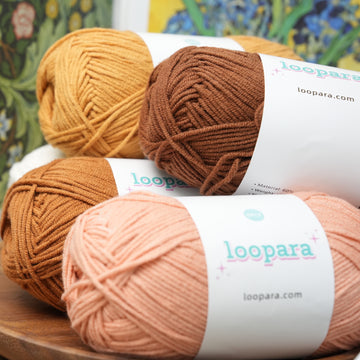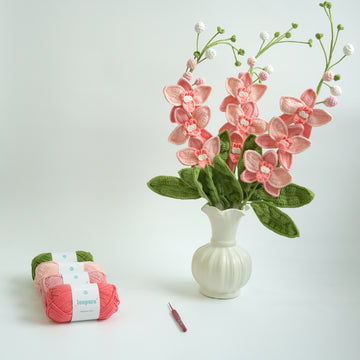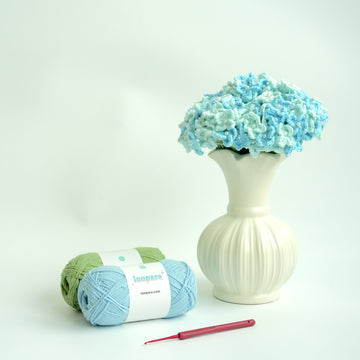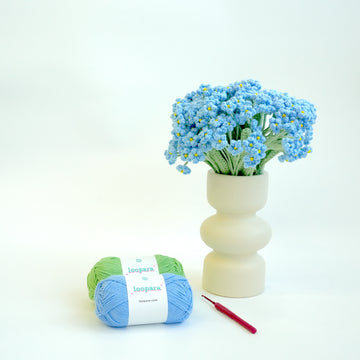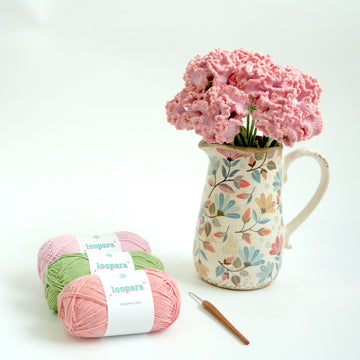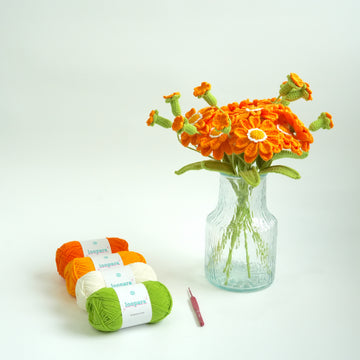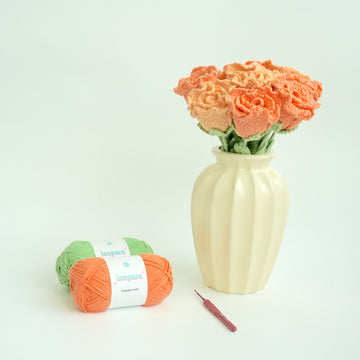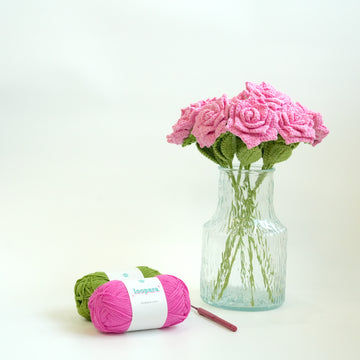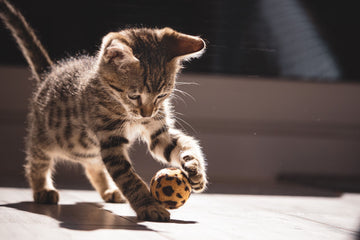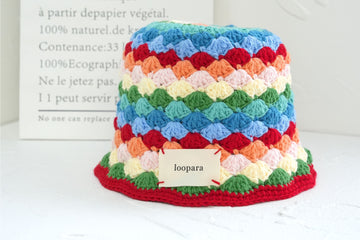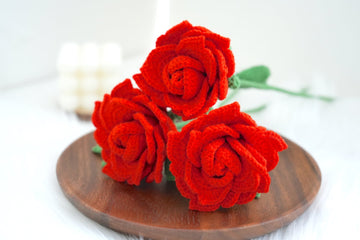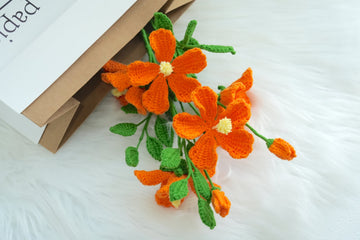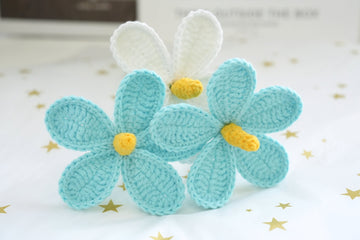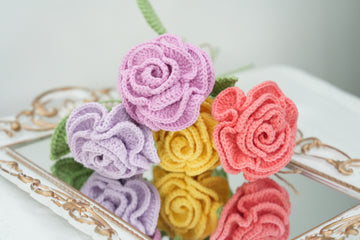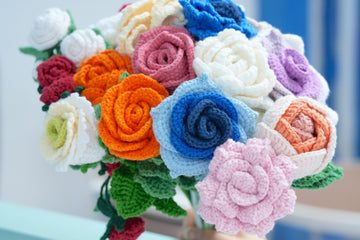If you’re just starting to learn a new craft, getting the right kit is the first step. So what do you need to crochet?
The good news is – not much! You can get started with just a crochet hook and some yarn. But there are different options for both. And as times goes by, you might want to invest in some additional accessories.
We’re going to take you through everything you need to get started on your crochet journey.
Basic equipment for crochet
When it comes to the equipment you need, crochet is one of the easiest crafts to get started with. All it requires is a length of yarn and a crochet hook.
If you’re just starting out, you can use whatever you have to hand. But it can be helpful to understand the different options that are available.
1. Crochet Hook

Different styles of crochet hook
The crochet hook is the tool you’ll use to make your stitches. You’ll probably find you want a set of hooks in different sizes as you become more experienced. At first, though, one is enough.
With all crochet hooks, the hooked part joins onto a straight section, called the shaft. At the end of the shaft is a grip.
The top of the hook is known as the “head”, and its underside is the “throat”. It’s the shape of the head which determines what type of hook you have. There are two main types:
- With inline hooks, the head aligns with the shaft. The head is pointier, and the throat a little deeper, than with tapered hooks.
- With tapered hooks, the head extends beyond the shaft. It’s a bit rounder, and the throat is shallower.
Different styles suit different people.
The pointier heads of inline hooks make it easier to get into tighter stitches. And some beginners find the deeper throat helps them to control the yarn better.
For others, tapered hooks are more comfortable to use because they don’t require as much twisting. That makes them easier to crochet with quickly, and less prone to splitting the yarn.
We’ve heard it suggested that your hook choice relates to your grip – whether you hold the hook as if it were a pen or a knife.
Inline hooks, the theory goes, suit pen grips better, because the yarn will stay on the hook more easily. Those who use the knife grip, on the other hand, might prefer the shallower throat of a tapered hook.
If you’re just learning to crochet, you’ll probably find either type of hook takes a bit of getting used to. But if you’ve been practising for a few hours and are still finding it awkward, try out the other type.
Different materials for crochet hooks
As well as the different styles, crochet hooks come in a variety of different materials. These include steel, aluminum. acrylic, wood and bamboo.
All have their pros and cons:
- Steel hooks allow the yarn to slide smoothly. But that means it’s also easier for the yarn to slip off. And because they’re not flexible, they can be hard on your hands.
- Aluminum hooks are similar. But they’re lighter than steel, so can be easier to maneuver.
- Acrylic hooks are smooth too. The yarn will slide along them easily, but that means it can be prone to slipping off. They’re more flexible than metal hooks but can snap if you apply too much force. Acrylic is also made from fossil fuels and isn’t biodegradable, so it’s not a great choice for the planet.
- Bamboo and other wooden hooks are light and naturally flexible, so they’re easy on your hands. The uneven surface can mean the yarn doesn’t slide as easily – good for avoiding unintentional slips, not so good for crocheting quickly.
The choice of material for your crochet hook boils down to your personal preference and crocheting style. If you find you keep losing the yarn off an acrylic hook, switch to bamboo. If you you’re struggling to slide your stitches off a wooden hook, try an aluminum one instead.
Don’t be afraid to experiment to find something that suits you.
Crochet hook size
Crochet hooks come in a range of sizes. The right size will depend on your chosen yarn and the effect you want to achieve. Generally speaking, the thicker the yarn, the bigger the recommended hook.
If you’re following a pattern, that will usually state what size hook you should use. If you’re not, the table below shows recommended hook sizes for different yarn weights.
|
Yarn weight |
Hook size - US |
Hook size - UK |
Hook size - metric |
Hook size - Japan |
|
0 – lace |
B |
14, 13 |
1.5mm – 2.25mm |
2/0, 3/0 |
|
1 – super-fine |
B, C |
13, 12, 11 |
2.25mm – 3mm |
3/0, 4/0, 5/0 |
|
2 – fine |
B, C, D, E |
12, 11, 10, 9 |
2.5mm – 3.5mm |
4/0, 5/0, 6/0 |
|
3 – light |
E, F, G |
9, 8, 7 |
3.5mm – 4.5mm |
6/0, 7/0, 7.5/0 |
|
4 – medium |
G, H, I |
7, 6, 5 |
4.5mm – 5.5mm |
7.5/0, 8/0, 9/0 |
|
5 – bulky |
I, J |
5, 4 |
5.5mm – 6.5mm |
9/0, 10/0 |
|
6 – super-bulky |
K, L, M |
2, 0, 00 |
6.5mm – 9mm |
7- jumbo, 8-jumbo, 9-jumbo |
|
7 – jumbo |
M, N |
00, 000 |
9mm+ |
10-jumbo |
2. Crochet Yarn

There’s a huge range of different yarns out there to choose from. They vary according to their thickness (known as their weight), the fiber they’re made from, and the way they’re spun.
Different yarns have different properties. When you’re just starting out, a good place to start is with a yarn that’s a light to medium weight. You’ll also hear this referred to as DK, Aran, light worsted or worsted.
Choosing something that’s easy on your hands is a good idea too. Wool or a softer cotton are good options. A cheaper alternative is a softer acrylic yarn (though if you wash it, it will leach microplastics).
A paler color will make it easier to see the stitches. Smoother yarns will be better than textured ones for the same reason.
Also Read: 4 Best Types of Yarn for Crochet
Other equipment for crocheting
Once you’ve got the basics of yarn and hook, you can start crocheting. But if you want to turn your stitches into a finished article, you’ll need some other equipment too.
The key things to get your hands on are:
3. A tape measure
This will allow you to check the gauge of your stitches and make sure your finished item will be the right size.
4. Crafting scissors
You’ll need to snip your yarn from time to time. Small, sharp crafting scissors are ideal, or you could use nail clippers.
5. Darning needles
You’ll use darning needles to weave in the ends of your crochet when you’ve finished. They have a thicker shaft than ordinary needles and a wider eye to accommodate heavier yarns.
6. Stitch markers
Stitch markers can be used to mark repeats, increases, decreases and so on. Make sure you use some designed specifically for crochet. Knitting markers won’t work.
7. Project bag
Use this to safely stow away your work in progress.
Once you’re more experienced, you may want to try different crocheting techniques. And some of these require different pieces of kit. These include:
8. Crochet tension rings

These are rings that sit on your finger and through which you thread your yarn. They’re designed to help you get a consistent tension in your stitches.
9. Yarn winders and swifts
Some yarn is sold in the form of skeins, and needs to be wound into a ball before use. It’s possible to do that by hand, but a yarn winder or swift will make the job a whole lot quicker.
10. Blocking boards
Blocking gives your crochet a professional finish. It involves moistening the item, then pinning it into shape on a board until it’s dry. It’s possible to buy blocking boards specifically for this purpose. But depending on the size of your item, an ironing board or children’s foam playmats can work just as well.
11. Wool wash
If you’re using woolen thread and want to block it, or just need to freshen up a finished item, wool wash is a must. It’s specially designed to gently clean woolen fibers without them matting or felting.
12. Yarn bowl
For cat-owning crocheters, yarn bowls can save a lot of frustration! They’ll keep the thread out of playful paws. And even pet-free crafters will appreciate not having to worry about their ball of thread rolling away at an inopportune moment.
What do you need to crochet? A quickfire summary
At its simplest, all you need to crochet is your choice of hook and yarn. A few other pieces of kit will be very helpful too – scissors to snip the yarn, a tape measure to keep track of the gauge, and darning needles to tuck away those loose ends.
But if you want to splash out, there are lots of fun accessories to choose from too. Everything from stitch markers to yarn bowls, project bags to tension rings, can be added to your collection.
Whatever accessories you choose to invest in, happy crocheting!


